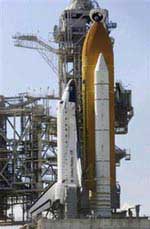 |
| The shuttle will remain for an additional 2 months. (Photo: AP) |
Yesterday, the U.S. space agency NASA announced that the launch of the Space Shuttle Discovery, originally scheduled for May, will be postponed by 2 months due to a very familiar issue: a malfunction in the fuel tank.
A similar malfunction had previously delayed the launch of Discovery last summer—the first flight back into space after the Columbia disaster in 2003.
NASA stated that they need time to open the hydrogen fuel tank and replace the sensors that are showing signs of malfunction. They also plan to replace all three other sensors located in the fuel tank to ensure safety.
These fuel control devices are designed to prevent the main engines from running too long or not long enough during the flight. An engine that shuts down at the wrong time could lead to disaster—forcing astronauts to find a way to make an emergency landing or resulting in complete engine failure.
“It is crucial that we fly safely. Therefore, replacing these sensors is absolutely necessary,” said Wayne Hale, NASA’s Space Shuttle Program Director.
Despite this setback, Hale believes that NASA can still launch 3 space shuttles this year. The sensor replacement work will take 3 weeks and will require a worker to crawl to the bottom of the 46.6-meter high vertical fuel tank.
The U.S. space agency had to plan meticulously to prepare for the upcoming launch in May, leaving very little time for any technical malfunctions that may occur. In recent months, NASA has also focused on modifying the external fuel tank of the shuttle to prevent insulation debris from being shed during liftoff—a problem that caused the Columbia disaster and resulted in the deaths of 7 astronauts.
Last summer, despite 2.5 years of continuous improvements and efforts to make the flight safer, a large piece of foam insulation broke off and struck the wing of Discovery during its launch.
M.T.


















































